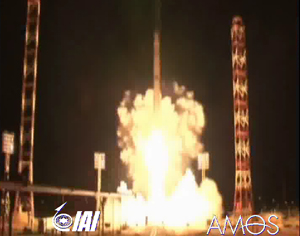

Amos 4 was built for Spacecom, a satellite communications service provider operating internationally from Israel. Amos-4 satellite was launched today (August 31, 2013) on 23:05 on a Zenit 3SLB rocket from Baikonur, Kazakhstan. According to IAI the satellite was successfully separated from the launcher and is transitioning to a geostationary orbit at an altitude of 36,000 kilometers, where it will park at 67.255° East position for in-orbit testing and preparation for deployment in its final position. More information available to members.
Once positioned at 65°E it will cover Russia, India and the Middle East with multiple Ku and Ka transponders creating a powerful platform, enabling a wide range of cross-band, cross-beam connectivity options. The AMOS satellite constellation currently includes AMOS 2, 3 and 5, providing a large range of fixed and mobile communication services in the Middle East, Central and Eastern Europe, Central Asia and Africa. The first Israeli communications satellite, Amos 1 ended its mission last year (2012) after 16 years in orbit (it was launched in 1996 for a ten-year mission).

Amos-4 undergoing testing at IAI before its delivery for the Baikonur launch site in Kazakhstan. Photo: IAI[/caption]Based on IAI’s latest Amos 4000 satellite bus, Amos 4 weighs 4.2 tons and packs 24 transponders operating in the Ku and Ka bands, create a powerful platform that enables a wide range of cross-band, cross-beam connectivity options. In addition to fixed antennae the satellite also operates ten steerable antennae enabling ad-hoc coverage supporting specific customers demands in nine regional areas in Asia, Africa, Europe and the Middle east.
”For our customers, this means extensive broadcast and broadband reach into the vast urban and rural areas of these regions.”Spacecom executives commented, explaining that such services could include Direct-To-Home (DTH), video distribution, VSAT communications and broadband Internet. With AMOS-4 the Israeli company strengthen its position as an international satellite communications provider, covering major growth markets including Russia and the Southern Russian Republics, the Indian subcontinent, SouthEast Asia, South Africa and the Middle east. “The new satellite will contribute to our rapid growth to new continents and growth markets, transforming our company from an international service provider into an international SATCOM supplier”. The new orbital slot enables Spacecom to expand its service with additional capacity, expanded coverage areas and cross-region connectivity, positioning Spacecom as a ‘multi-regional’ satellite operator.

IAI currently has several satellite programs underway, for communications and surveillance satellites. IAI is working on the next generation satellite for Spacecom – AMOS 6, in parallel to other reconnaissance satellite programs. In addition, the company is also seeking new programs in Latin America.
Winning the Amos 6 program was not an easy task. While selling an Israeli satellite to an Israeli SATCOM company may seem obvious, the customer negotiated a tough bargaining, with IAI facing the world’s largest satellite builders from Europe, Russia and the USA, fighting for the international tender, eventually winning the bid for the $200 million development, manufacturing and operation over its 16 operational lifespan. Amos-6 is scheduled for launch in the first quarter of 2015.
Spacecom will have to allocate an additional amount of $85 million for the satellite launch, insurance and and first year of service, which are not included in the IAI contract. Space Exploration Technologies Falcon 9 rocket by 2015.

















